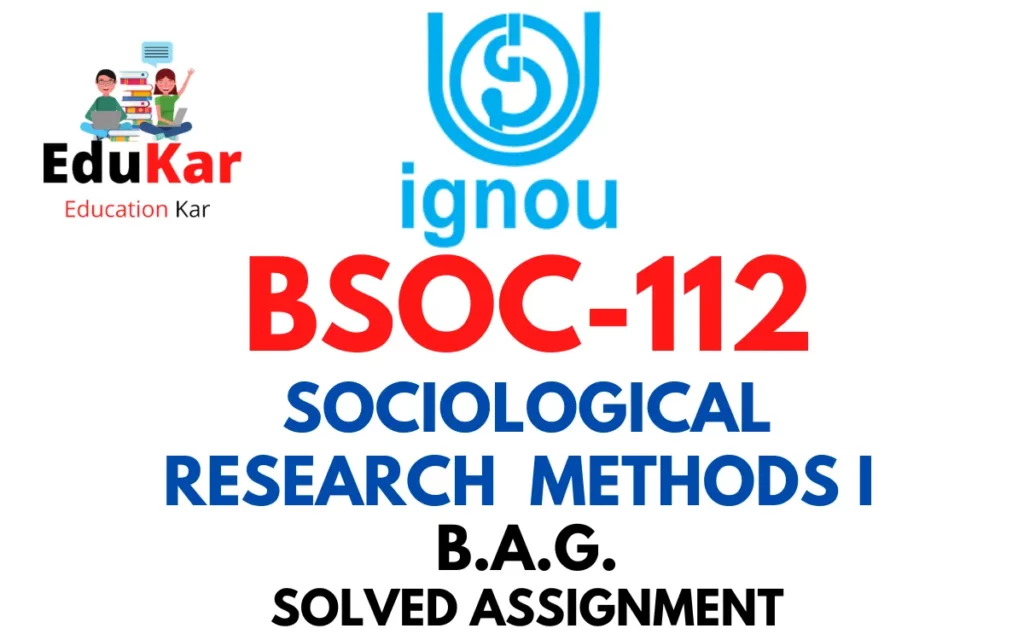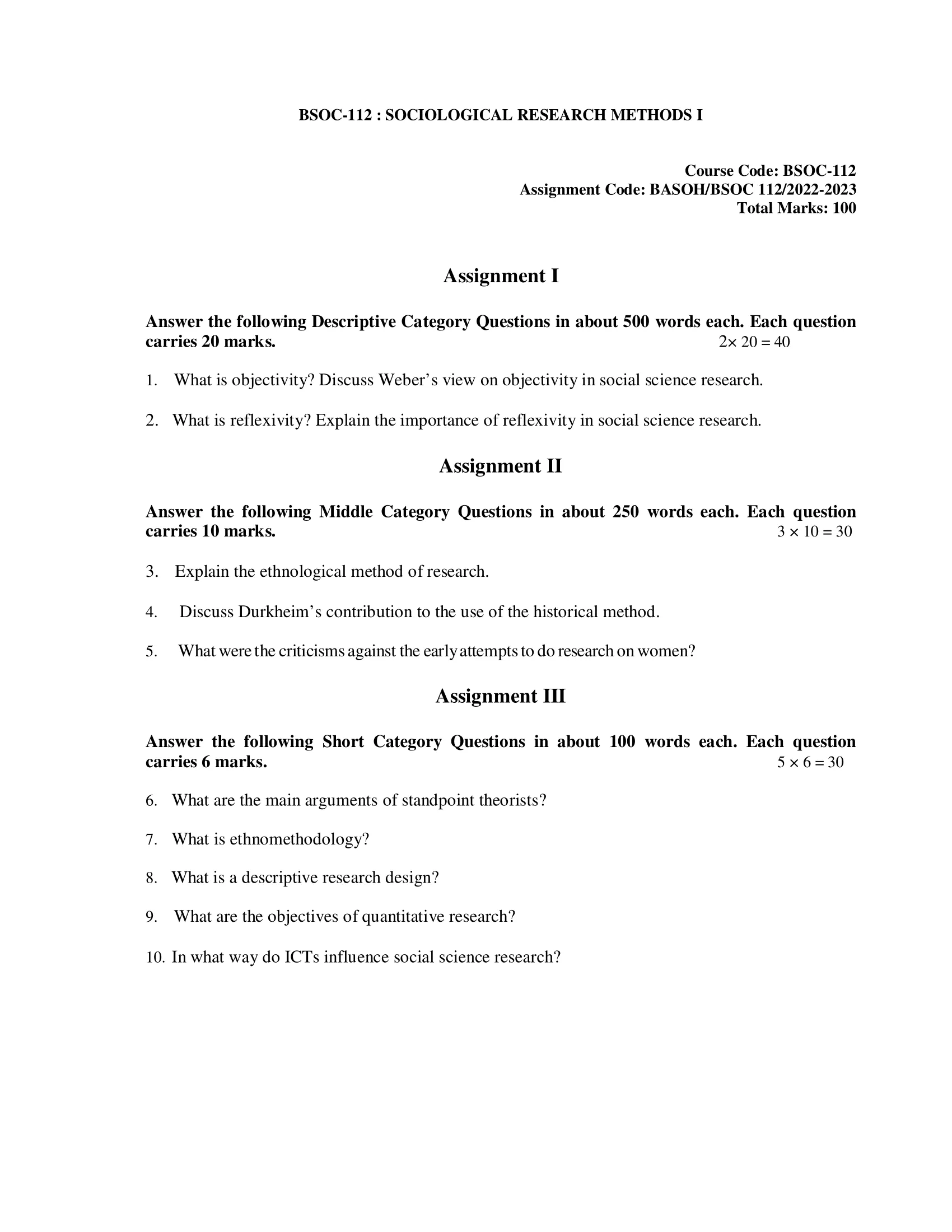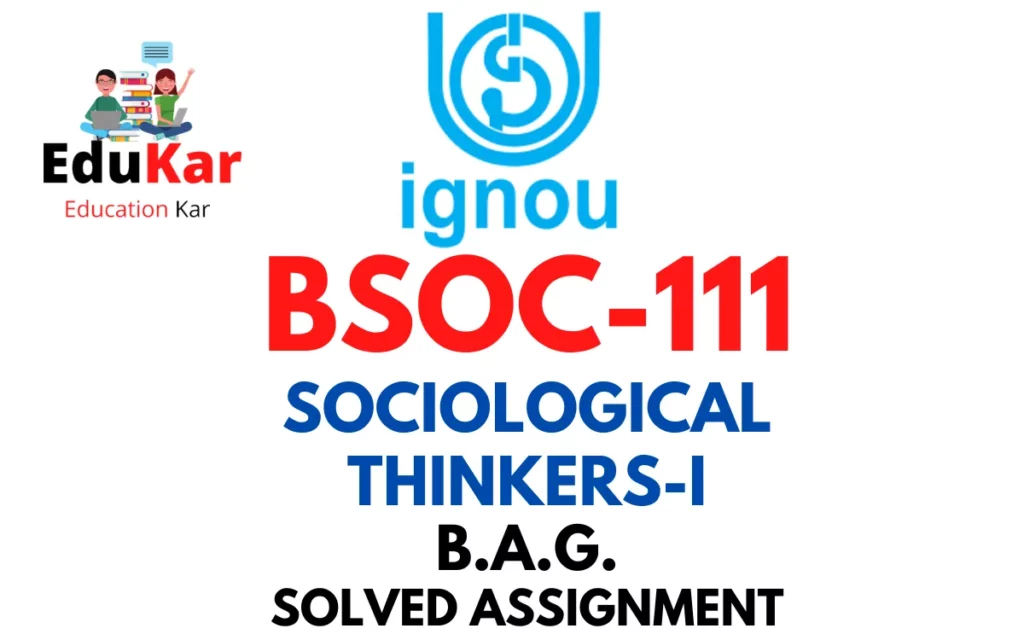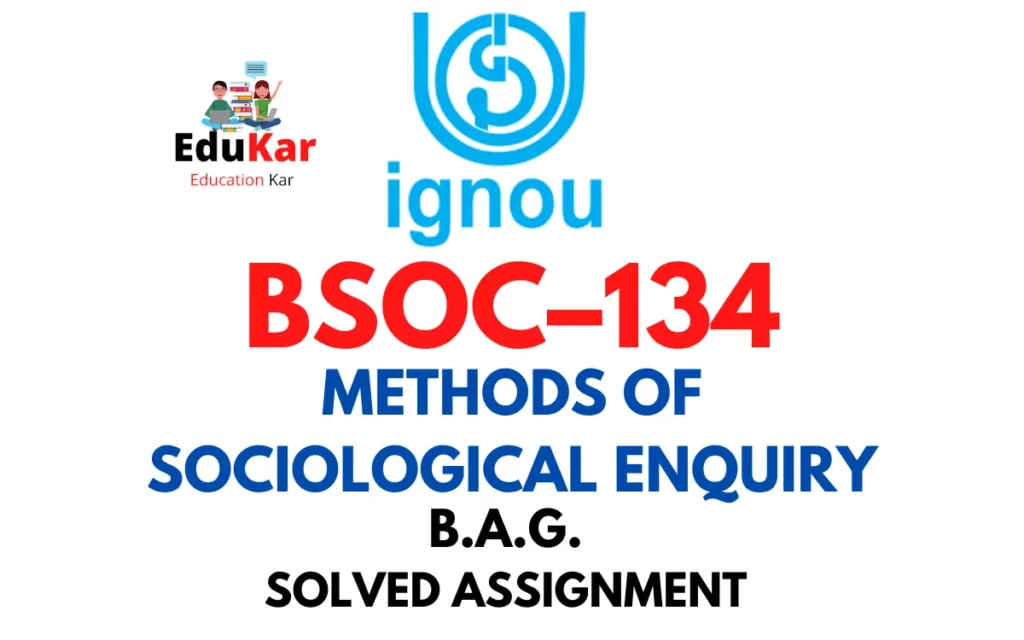Contents
- 1 Assignment I
- 2 Answer the following Descriptive Category Questions in about 500 words each. Each question carries 20 marks.
- 3 1. What is objectivity? Discuss Weber’s view on objectivity in social science research.
- 4 2. What is reflexivity? Explain the importance of reflexivity in social science research.
- 5 Assignment II
- 6 Answer the following Middle Category Questions in about 250 words each. Each question carries 10 marks.
- 7 3. Explain the ethnological method of research.
- 8 4. Discuss Durkheim’s contribution to the use of the historical method.
- 9 5. What were the criticisms against the earlyattemptsto do research on women?
- 10 Assignment III
- 11 Answer the following Short Category Questions in about 100 words each. Each question carries 6 marks.
- 12 6. What are the main arguments of standpoint theorists?
- 13 7. What is ethnomethodology?
- 14 8. What is a descriptive research design?
- 15 9. What are the objectives of quantitative research?
- 16 10. In what way do ICTs influence social science research?

| Title | BSOC-112: IGNOU BAG Solved Assignment 2022-2023 |
| University | IGNOU |
| Degree | Bachelor Degree Programme |
| Course Code | BSOC-112 |
| Course Name | SOCIOLOGICAL RESEARCH METHODS I |
| Programme Name | Bachelor of Arts (General) |
| Programme Code | BAG |
| Total Marks | 100 |
| Year | 2022-2023 |
| Language | English |
| Assignment Code | BASOH/BSOC 112/2022-202 |
| Assignment PDF | Click Here |
| Last Date for Submission of Assignment: | For June Examination: 31st April For December Examination: 30th September |

Assignment I
Answer the following Descriptive Category Questions in about 500 words each. Each question carries 20 marks.
Ans: Objectivity is a key concept in social science research that refers to the ability to conduct research without any personal biases, values, or beliefs that could influence the research findings. It involves an unbiased and neutral approach to research, where the researcher strives to eliminate any subjective interpretations of data, observations, or experiences. Objectivity is essential in social science research because it helps to ensure the validity, reliability, and generalizability of research findings.
Max Weber, a prominent social scientist, had a significant impact on the development of the concept of objectivity in social science research. According to Weber, objectivity in social science research means that the researcher must strive to eliminate any subjective bias that could influence the research findings. Weber argued that social scientists must adopt an objective perspective that is free from their personal biases and values.
Weber believed that objectivity in social science research could be achieved through the use of the ideal type. An ideal type is a theoretical construct that represents the essential features of a particular social phenomenon. It is not an empirical reality but rather a tool that the researcher uses to understand the social world.
Weber argued that the use of ideal types could help social scientists to achieve objectivity in their research by enabling them to identify the essential features of a social phenomenon and distinguish them from the non-essential features. By doing so, social scientists can develop a clearer and more objective understanding of the social phenomenon under investigation.
Weber also believed that social scientists must adopt a value-free approach to their research. According to Weber, social scientists must separate their personal values and beliefs from their research to achieve objectivity. This means that the researcher should not allow their personal values or beliefs to influence the research process, data collection, or data analysis.
Weber’s view on objectivity in social science research has been subject to criticism. Some argue that it is impossible to eliminate all subjective biases from social science research because researchers are a part of the society they are studying, and their social position and experiences may influence their research findings. Others argue that objectivity is not desirable in social science research because it can lead to a detached and dehumanized view of the social world, which may overlook the human experience.
Ans: Reflexivity is a concept in social science research that refers to the process of reflecting on the researcher’s role in the research process and the impact of their values, assumptions, biases, and experiences on the research findings. It involves a critical self-awareness and self-examination of the researcher’s positionality and subjectivity in relation to the research process.
Reflexivity is crucial in social science research because it acknowledges that researchers are not neutral or objective observers of the social world but rather active participants in the research process. Researchers bring their values, assumptions, and experiences to the research process, which can shape the research questions, data collection, data analysis, and interpretation of findings. Therefore, reflexivity helps to ensure that the research process is transparent and self-aware, enabling researchers to acknowledge and address their own subjectivity and potential biases in the research process.
The importance of reflexivity in social science research can be seen in several ways:
- Acknowledgment of Researcher Bias: Reflexivity helps researchers to acknowledge and address their own biases, values, and assumptions that could influence the research process and findings. By reflecting on their own positionality, researchers can identify potential biases and take steps to minimize their impact on the research.
- Transparency: Reflexivity promotes transparency in the research process by making the researcher’s positionality and subjectivity explicit. This enables readers of the research to understand the researcher’s perspective and potential biases, allowing them to critically evaluate the research findings.
- Empowerment of Research Participants: Reflexivity can empower research participants by acknowledging their voices and experiences in the research process. By reflecting on their own positionality, researchers can recognize and challenge the power dynamics that exist between the researcher and the research participants.
- Enhancement of Research Quality: Reflexivity can enhance the quality of social science research by enabling researchers to identify potential biases and limitations in the research design and methodology. By reflecting on the research process, researchers can identify areas for improvement and make changes that can improve the validity, reliability, and generalizability of the research findings.
Assignment II
Answer the following Middle Category Questions in about 250 words each. Each question carries 10 marks.
3. Explain the ethnological method of research.
Ans: The ethnological method of research is a qualitative research approach that involves studying and understanding the social and cultural aspects of a particular group or community. It is an empirical research method used by anthropologists and sociologists to gain insights into the beliefs, practices, values, and norms of a particular society or culture.
The ethnological method involves conducting extensive fieldwork and observing the social interactions and behaviors of individuals within a specific cultural context. The researcher typically spends an extended period living among the people they are studying, developing relationships with them, and learning their language and customs. This immersive experience enables the researcher to gain a comprehensive understanding of the group’s way of life, including its history, social structure, and cultural practices.
Ethnographic data is often collected through a variety of methods, including participant observation, interviews, surveys, and document analysis. Researchers may also use visual media, such as photographs and videos, to document and analyze cultural practices and behaviors.
Once the data is collected, the researcher typically engages in a process of analysis and interpretation, seeking to identify patterns and themes within the data. This process involves triangulating data from multiple sources to ensure its validity and reliability. The end result is a comprehensive and in-depth understanding of the culture or society being studied, which can be used to inform policy decisions, social interventions, or further research.
4. Discuss Durkheim’s contribution to the use of the historical method.
Ans: Emile Durkheim is widely regarded as one of the founding figures of sociology, and his work has had a significant impact on the development of the discipline. One of Durkheim’s major contributions was his use of the historical method to understand the social and cultural dynamics of different societies.
Durkheim believed that the key to understanding social phenomena was to view them in their historical and cultural context. He argued that social facts – the shared norms, values, and beliefs that underpin social life – were products of historical and cultural forces, and could not be understood without considering the broader social and historical context.
To this end, Durkheim advocated for the use of the historical method in sociological research, which involves tracing the historical development of social phenomena over time. He argued that by examining the historical development of social institutions, practices, and beliefs, researchers could gain a better understanding of the social forces that shaped them and the broader social context in which they existed.
Durkheim’s use of the historical method was particularly evident in his study of religion, which he argued was a fundamental social institution that played a crucial role in shaping the social and cultural dynamics of different societies. In his classic work “The Elementary Forms of Religious Life,” Durkheim used historical and comparative methods to analyze the nature of religious beliefs and practices in different cultures, arguing that they reflected broader social and cultural forces at work in those societies.
Durkheim’s use of the historical method helped to establish the importance of historical and cultural context in sociological research. His approach paved the way for subsequent sociologists to use similar methods to analyze other social phenomena, such as economic systems, political institutions, and cultural practices. Today, the historical method remains an important tool in sociological research, and Durkheim’s work continues to influence the development of the discipline.
5. What were the criticisms against the earlyattemptsto do research on women?
Ans: Early attempts to do research on women were subject to a range of criticisms, many of which highlighted the problematic assumptions, biases, and limitations of the research. Some of the most significant criticisms of this research are discussed below:
- Bias and Stereotyping: Early research on women was often influenced by biased assumptions about women’s nature and capabilities. Researchers often relied on stereotypes and gendered assumptions, which led to a distorted view of women’s lives and experiences. For example, women were often portrayed as passive and submissive, while men were seen as active and dominant.
- Lack of Representation: Many early studies of women were conducted by male researchers, which limited the perspectives and experiences represented in the research. This lack of representation made it difficult to draw accurate conclusions about the experiences of women and contributed to the marginalization of women’s voices and experiences in research.
- Limited Scope: Early research on women was often limited in scope, focusing on narrow topics such as domestic work, motherhood, and sexuality. This limited scope prevented a more comprehensive understanding of women’s lives and experiences and reinforced traditional gender roles and expectations.
- Ethnocentrism: Many early studies of women were conducted in Western societies, which made it difficult to generalize the findings to other cultural contexts. This ethnocentric approach to research failed to recognize the diversity and complexity of women’s experiences across different societies and cultures.
- Lack of Intersectionality: Early research on women often failed to recognize the intersectional nature of gender, race, class, and other social categories. This lack of intersectionality made it difficult to understand the complex ways in which different social identities intersect and shape women’s experiences.
Assignment III
Answer the following Short Category Questions in about 100 words each. Each question carries 6 marks.
6. What are the main arguments of standpoint theorists?
Ans: Standpoint theorists argue that social positions and identities shape our perspectives and experiences of the world. They argue that people from different social positions and identities have different experiences and understandings of the social world, and that those experiences and understandings are valuable sources of knowledge. Standpoint theorists also argue that some social positions and identities are more privileged than others, which can lead to unequal power relations in society. They believe that by understanding the experiences and perspectives of marginalized groups, we can develop a more comprehensive and accurate understanding of the social world, and work towards greater social justice and equality.
7. What is ethnomethodology?
Ans: Ethnomethodology is a sociological perspective and methodological approach that focuses on the ways in which people make sense of their everyday lives and social worlds. Ethnomethodologists argue that people rely on common-sense knowledge and shared understandings to navigate social interactions and create order in their lives. They are interested in the ways in which people create and use social norms, rules, and practices to make sense of the social world and accomplish their goals.
Ethnomethodology emphasizes the importance of studying the actual practices and methods that people use to make sense of their social worlds, rather than relying on preconceived notions or assumptions about social order. Ethnomethodologists use a variety of research methods, including ethnographic observation and conversation analysis, to study the everyday practices and interactions of people in different social settings.
8. What is a descriptive research design?
Ans. A descriptive research design is a type of research design that is used to describe or summarize the characteristics of a particular phenomenon or group. This design is used to answer questions such as “what”, “where”, “when”, and “how” about a particular phenomenon, but not necessarily why. Descriptive research designs are often used in social sciences, psychology, education, and other fields to gather information about a particular population or phenomenon.
Descriptive research designs are typically non-experimental and involve collecting data through surveys, observations, or interviews. The data collected is often analyzed using descriptive statistics such as means, standard deviations, and frequency distributions. This type of research design can be used to generate hypotheses for future research or to provide information that can be used for decision-making purposes.
9. What are the objectives of quantitative research?
Ans: The objectives of quantitative research are to measure and quantify variables, test hypotheses, and provide generalizable findings based on statistical analysis.
Here are some more specific objectives of quantitative research:
- Describe and measure phenomena: One of the primary objectives of quantitative research is to describe and measure the variables and phenomena under investigation. This involves collecting numerical data through structured methods such as surveys, questionnaires, or experiments.
- Test hypotheses: Another important objective of quantitative research is to test hypotheses or research questions by collecting and analyzing data using statistical methods. This involves using numerical data to test the relationship between variables, assess the strength and direction of associations, and identify any significant differences or trends.
- Generalize findings: A key objective of quantitative research is to produce generalizable findings that can be applied to a broader population. This involves using probability sampling methods to ensure that the sample is representative of the population, and using statistical analysis to estimate population parameters.
- Identify cause-and-effect relationships: Another objective of quantitative research is to identify cause-and-effect relationships between variables. This is often done through experimental designs, where one variable is manipulated and the effect on another variable is measured.
- Provide accurate and reliable data: Finally, the objective of quantitative research is to provide accurate and reliable data that can be used to inform decision-making, policy, and practice. This involves using standardized data collection methods, minimizing bias and error, and ensuring that data analysis is transparent and replicable.
Ans: Information and Communication Technologies (ICTs) have had a significant impact on social science research in several ways:
- Data collection: ICTs have revolutionized data collection methods in social science research. Online surveys, social media, mobile apps, and other digital tools have made it easier and more cost-effective to collect data from large and diverse populations. This has increased the speed and efficiency of data collection, and made it easier to reach respondents in different parts of the world.
- Data analysis: ICTs have also had a significant impact on data analysis in social science research. Statistical software packages, such as SPSS, R, and SAS, have made it easier to analyze large and complex data sets, and to perform sophisticated statistical analyses. This has enabled researchers to identify patterns, trends, and relationships in the data that would be difficult or impossible to detect using manual methods.
- Communication and collaboration: ICTs have also made it easier for social science researchers to communicate and collaborate with each other. Email, video conferencing, and other digital tools have made it easier to share ideas and data, and to work together across different locations and time zones. This has increased the speed and efficiency of research, and made it easier to build networks and collaborations.
- Access to information: ICTs have also made it easier for social science researchers to access information and resources. Online databases, digital archives, and other resources have made it easier to find and access research articles, books, and other materials. This has made it easier to conduct literature reviews, and to stay up-to-date with the latest research in a particular field.
- Ethical considerations: Finally, ICTs have also raised new ethical considerations in social science research. For example, issues such as data privacy, informed consent, and the use of digital data have become increasingly important as more research is conducted using digital tools and platforms.
How to Download BSOC-112 Solved Assignment?
You can download it from the www.edukar.in, they have a big database for all the IGNOU solved assignments.
Is the BSOC-112 Solved Assignment Free?
Yes this is absolutely free to download the solved assignment from www.edukar.in
What is the last submission date for BSOC-112 Solved Assignment?
For June Examination: 31st April, For December Examination: 30th October
















